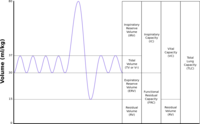
Photo from wikipedia
A lower socio-economic status (SES) associates with increased morbidity and mortality. The goal of this study was to define the influence of SES on lung function in indigenous male adolescents… Click to show full abstract
A lower socio-economic status (SES) associates with increased morbidity and mortality. The goal of this study was to define the influence of SES on lung function in indigenous male adolescents (aged 12.8-24.5 years) in Tanzania. The subjects were subdivided into two age groups: <17.5 (n = 189) and ≥ 17.5 years of age (n = 101). They underwent anthropometric and spirometry evaluation. The SES was assessed on the basis of economic family resources and the subjects' nutritional status, and was stratified into three categories: SES-1 (low), SES-2 (average), and SES-3 (high). Relative contributions of body mass index, chest expansion/mobility, waist-to-chest ratio, and SES to spirometry variables were statistically determined. We found significant differences in forced expiratory volume in 1 s (FEV1) and forced vital capacity (FVC) in the older, but not younger age group, by the SES category. The adolescents aged ≥17.5 in high-SES-3 category had FEV1 and FVC greater by 29.3% and 42.5%, respectively, than those in low-SES-1 category in the same age group. There also were differences between the two age groups. The mean FEV1 and FVC in adolescents of high-SES-3 category, aged ≥17.5, were higher by 65.3% and 82.2%, respectively, than those in the corresponding SES-3 in adolescents aged <17.5. In younger adolescents, lung function variables associated mostly with body build parameters, whereas in older adolescents with SES. The study revealed a significant dependence of lung function, and thus plausibly a greater resistance to diseases, on the socio-economic status. We conclude that the socio-economic status be taken into consideration in the assessment of lung function in epidemiological and public health programs, particularly in the context of the developing countries, to obtain the most reliable results.
Journal Title: Advances in experimental medicine and biology
Year Published: 2019
Link to full text (if available)
Share on Social Media: Sign Up to like & get
recommendations!